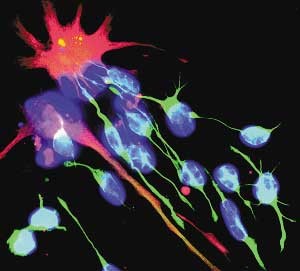
Stem Cells in a Nutshell
on
WordExplain
by Amy Budke
 |
Stem Cells in a Nutshell on WordExplain by Amy Budke |
"For You formed my inward parts; You wove me in my mother's womb." Psalm 139:13 |
                   |
Stem
Cells in a Nutshell
There is a raging debate today in our country over the use of stem cells and Somatic Cell Nuclear Transfer (SCNT) or therapeutic cloning. This debate can be hard to understand because it involves science and politics. Moreover, the media blurs the data and the information about the use of stem cells, therefore confusing matters even further. In order to stand firm on this debate one must understand what stem cells are, how they are used for research and therapies, and the impact and consequences of their use. Stem cells are generic cells that have the ability to become specific cells. There are two basic categories of stem cells: embryonic and adult. Early embryonic stem cells are less than seven days old. These cells are totipotent, which means they have the ability to become any type of tissue because they have not yet differentiated. Embryonic stem cells between seven days and eight-weeks old are pluripotent. These cells can become almost any cell. Embryonic stem cells are sought out because scientists believe that “these stem cells could be used to create an unlimited supply of cells, tissues, or even organs that could be transplanted to restore function lost to disease and injury” (https://www.kumc.edu/stemcell/intro.html). Adult stem cells, which are also in children and infants, are mature stem cells that have a limited range of development. They are also called multipotent. Adult stem cells can be found in many locations such as nerves, blood, bone marrow, bones, muscle, skin, umbilical cords, etc. There are three basic methods of obtaining stem cells needed for therapies: In Vitro fertilization, cloning (SCNT) and adult stem cell donation. The first two methods are controversial. The In Vitro method uses embryonic cells that are left over from fertility treatments or donated by women. This technique uses an embryo that is at the eight-cell stage. In theory these cells could be directed to grow into certain organs or tissues and transplanted into patients. The second method is Somatic Cell Nuclear Transfer (SCNT) also know as cloning. A very generalized description of the SCNT process involves six steps. 1.
Using hormone therapy the egg donor (a female) ovulates a large amount
of unfertilized eggs.
2.
The eggs are harvested.
3.
The genetic material in the cells (the female’s DNA) is removed or
enucleated.
4.
DNA or
genetic material from another organism or person’s body cells
(somatic cells) is harvested.
5.
The Somatic DNA is placed into the empty egg cells and zapped with
electricity.
6.
The egg
cells with the new DNA is placed into the womb for cloning or grown in
a lab for embryonic stem cell therapy.
A hypothetical example of SCNT would be something like Jane Doe has a spinal cord injury. Doctors could take a DNA sample from Jane’s skin cells. Jane’s DNA would then be placed into an egg for SCNT. Then these new embryonic cells would be genetically identical to Jane. The cells would be planted into Jane’s wounded spinal cord. There they would, in theory, produce new spinal cord cells to repair and replace the nonfunctioning cells. If these cells were allowed to fully develop in a womb they would produce Jane’s clone. However, there is no published data confirming any therapeutic success with embryonic cells. “Most cloned animals die before birth, and of those born alive, not even half survive for three weeks. In the best case, there is a success rate of 3 to 4 percent” (https://www.21stcenturysciencetech.com/articles/winter01/stem_cell.html). The third method uses adult stem cells. Adult stem cell therapies are very fruitful and research with them continues to surpass embryonic stem cell research. Adult stem cells are extracted from different locations depending on the type of cells needed. Regardless of the source, there is no loss of life for the donor, and often times patients can donate their own stem cells to be used for their own treatments. “Therapies using stem cells from sources such as bone marrow, umbilical cord blood, the brain and nose have already successfully treated patients with: Multiple Sclerosis, heart disease, Sickle Cell Anemia, spinal cord injuries, cancer, Leukemia, and Parkinson’s disease. There are currently at least 67 human clinical applications using adult stem cells” (https://www.citizenlink.org/images/votenocloning/learn-missourians.html). Many of the embryonic stem cell proponents argue that embryonic stem cells are not yet human, but rather a glob of tissue. So, when exactly does human life begin? And at what nanosecond do those cells become a human life? The Bible repeatedly states how mysteriously and secretly we are created. Psalm 139: 13-16 states: For you created my
inmost being;
you knit me together in my mother’s womb. I praise you
because I am fearfully and wonderfully made; your works are wonderful,
I know that full well.
My frame was not
hidden from you
when I was made in the secret place. When I was woven
together in
the depths of the earth, your eyes saw my unformed body. All
the
days ordained for me were written in your book before one of them came
to be. Ecclesiastes 11: 5 states, “As you do not know the
path of the wind, or
how the body is formed in a mother’s womb, so you cannot understand the
work of God, the Maker of all things.” As Christians, it is
important
that we work to protect the unborn—at all developmental stages—because
we do not and will not understand the work of God.
So, in a nutshell—all forms of human embryonic stem cell research require the loss of life. Somatic Cell Nuclear Transfer is Cloning. Embryonic stem cell research has not been successful. Adult stem cell therapy and research is very successful. Harvesting adult stem cells doesn’t require the loss of life. As Christians we should support adult stem cell research. And finally, it is imperative that we protect the unborn—no matter the stage of development.  Brain Stem Cells Go to https://stanmed.stanford.edu/2003winter/stem_cells.html to see this image in its original context. For additional information go to: Disclaimer:
WordExplain endorses the moral and ethical stance of some,
but not each of the web sites listed on this page.
About
the Author
Amy Budke is a former high school Biology Teacher. She has her B.S. in Fisheries and Wildlife Biology and a minor in General Biology from the University of Missouri. She has her Master’s in Curriculum and Education from UMKC. Amy is a Leukemia survivor. She had a bone marrow transplant in 1996. A bone marrow transplant involves removing bone marrow—which contains adult blood stem cells—from a donor and transplanting this cancer-free marrow in to the patient. Today Amy is very healthy and extremely thankful for the generous gift from her donor, Andy. Go
to Embryonic Stem Cells Webquest
Developed by Amy Budke Published
November 5, 2010
Updated March 24, 2014 |